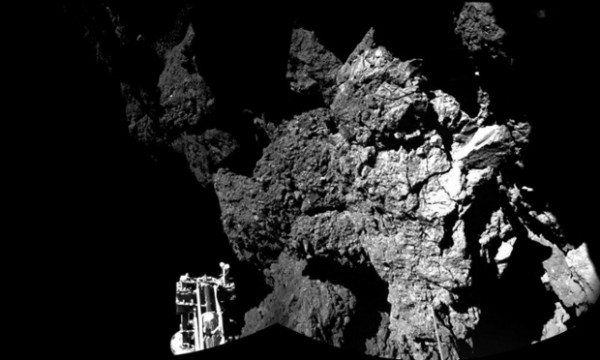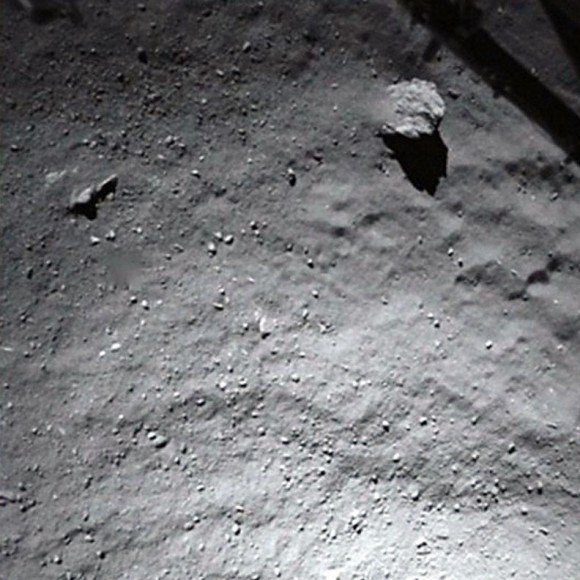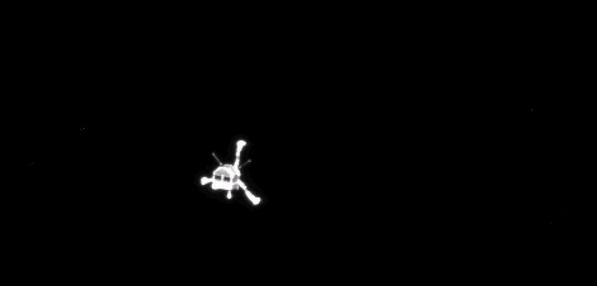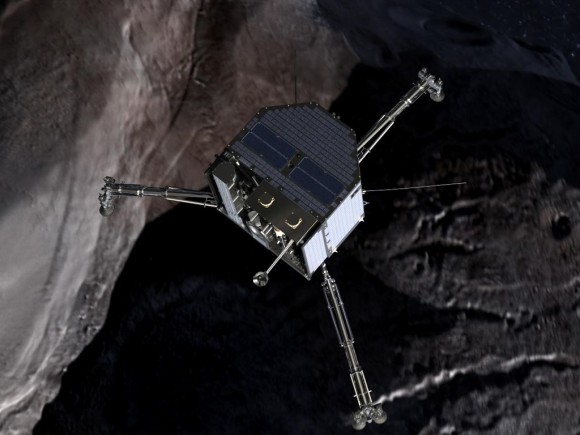
Ten years after its launch, the Rosetta mission made history Wednesday (November 12, 2014) by landing – albeit a bouncy landing – on the surface of a comet. From a distance in space of more than 300 million miles (500 million km), the Philae (fee-LAY) lander sent confirmation of its own successful touchdown on the surface of Comet 67P/Churyumov-Gerasimenko at 10:05 a.m. CDT (1605 UTC) on Wednesday. As of Thursday morning, November 13 – after initially failing to attach to the surface – Philae now appears stable and is sending back data. Watch for press briefings via rosetta.esa.int. Follow the mission on Twitter via @ESA_Rosetta.
The landing was successful despite the loss of the downward thruster, and the two harpoons, which did not fire. Philae bounced and actually landed three times, bouncing back up a kilometer (.6 miles) the first time, nearly bouncing back into space. The lander’s ice screws also did not activate, and Philae has apparently slipped down a slope but remains upright.
There is also concern that the lander’s solar arrays are not generating sufficient power, because the lander appears to be in an area that is darker than expected. Its batteries have a 50-hour charge time without recharging. If the lander’s battery dies, however, the lander will go into a sort of “hibernation,” awaiting the return of the sun as the comet’s “seasons” change.

ESA posted this Rosetta operations update on Thursday, November 13:
Rosetta is operating nominally; the network systems and overall ground segment to control the mission are nominal.
Last night, Rosetta lost contact with Philae as expected when it orbited below the horizon just after 20:00 CET.
Contact was re-established this morning at 06:01 UTC, and the Philae-Rosetta radio link was initially unstable.
As Rosetta rose higher above the Philae landing site, the link became very stable and the lander could transmit telemetry (status and housekeeping information) and science data from the surface.
This morning’s surface link was again lost due to Rosetta’s orbit at about 09:58 UTC … with the current orbit, Rosetta will have, typically, two Philae communication windows per day.
The next window opens at 19:27 UTC on the spacecraft and runs through to 23:47 UTC spacecraft time.
The team are ensuring that Rosetta maintains an orbit that is optimized for lander communication support; they are planning a thruster burn today to be conducted on Friday that will help keep Rosetta where it should be. Rosetta already conducted a burn last night as part of this effort.
As Philae detached from its mothership, an eerie comet song
Scientists are expecting that the probe will analyze the comet’s surface to yield insights into the origins of our solar system. Kathrin Altwegg of the University of Bern in Switzerland, who is one of Rosetta’s project leads, said of the comet:
It’s a look at the basic building blocks of our solar system, the ancient materials from which life emerged. It’s like doing archaeology, but instead of going back 1,000 years, we can go back 4.6 billion.
The news of the successful touchdown came after a night of uncertainty following the lander’s separation from its mothership, the Rosetta spacecraft. Scientists looked tired, but obviously relieved and very excited when Philae signaled it was in operation on the comet’s surface.







Bottom line: Congratulations, ESA and Rosetta mission scientists, for the first successful soft landing on a comet, despite great difficulties!











